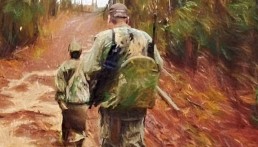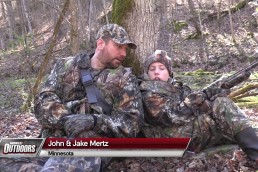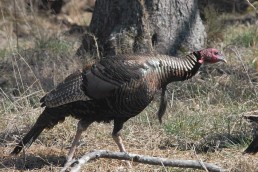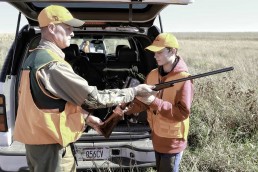The Importance of Being Quiet
SHARE THIS POST
Confucius said: “Silence is a true friend who never betrays.”
I seriously doubt the Chinese philosopher ever chased Easterns in woodlots or big timber, but his quote holds a lot of water in modern times, especially when we’re talking about turkey hunting.
It’s hard enough to bag a big-boss gobbler, and turkey hunters need to do all they can to keep the odds in their favor. Being quiet and not alerting turkeys to any human presence is one of the most important aspects.
Whether your hunt is before first light, during late morning, at midday or in the afternoon, it’s all the same—you’ll want to be as silent as possible.
Here are elements to consider for all phases of a turkey hunt:
Before the hunt
Practice with your shotgun. It’s true that a hunter should shoot and pattern his designated turkey gun, but what I am mentioning is different and just as important: Practice loading your gun quietly. A pump can be loaded quietly if practiced; an automatic is more difficult, but it’s possible. Even a single-shot, double-barrel or an over-and-under gun can make noise when they have ejectors instead of extractors.
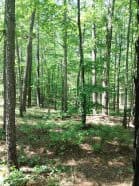
If the game laws in your state allow it, load your gun inside your vehicle with the doors closed. This is the quietest means necessary, especially for auto-loaders when the bolt has to be slammed shut. And, keep your gun clean; the cleaner the action, the quieter it will be.
Next, practice taking the gun off the safety, while it’s unloaded, of course. As you know, that distinct metallic-sounding “click” can be very loud in the turkey woods. All creatures recognize this abrupt sound as something very bad is about to happen, and a tom can vacate the premises before you can draw a bead on him. All safeties can be taken off relatively silently before the moment of truth arrives.
Driving to your spot
Unless you’re blessed and fortunate enough to walk out your back door and hunt turkeys, you’ll have to drive to wherever your birds are located. Plan driving to a parking place well out of hearing distance of your quarry.
If the turkeys are close to a road, try to avoid driving past them to park and come from another direction if possible. They can hear approaching vehicles and know something is up, even after you park. Keep in mind that when you pull out of a public road or right-of-way, tires on gravel make noise. This sound will echo on a clear, crisp morning. I’ve been on too many hunts to count, that while I was working a tom, he would shock-gobble at a truck traveling with tires crunching down a gravel road.
I would recommend parking at least one-half mile from turkeys. Farther would be even better, especially at the beginning of the season when there is minimal new growth on trees to dampen sounds.
Walking in
Take the path of least resistance and sneak in. Find old logging roads or well-worn trails used by deer hunters. These are usually located on top of ridges for easy and quiet walking. Walk slow and steady, looking a few steps out ahead of where your boots will strike the ground. Avoid stepping on sticks or twigs. They’ll snap and sound off an alarm alerting all animals. Stay clear of crunchy leaves and briars or limbs brushing against your clothes. Walking on areas with rainwater runoff is always a quiet path to take when slipping in.
Are you enjoying this post?
You can be among the first to get the latest info on where to go, what to use and how to use it!
During the hunt
You may have to walk across hollows, over ridges or through open woods to get close to gobbling toms or to where you think turkeys are. This is when you’ll get off “the beaten path” and the woodsmanship skills need kick in. Proceed toward your prey stealthily, moving slowly and carefully, watching for turkeys or signs of them.
Walk with very short strides while slipping along. This will slow you down, helping you produce less movement. Look down where you will step, stop, and scan the area, and then look where you’ll step next. You’ll be able to spot sticks and limbs in your path. This is very effective when stalking.
When any deer, crows, squirrels, coveys of quail, etc., are spotted, let them pass. Avoid spooking these lookouts, as turkeys recognize the sounds and reactions of other animals as a predator nearby.
If you’re hunting with a buddy, do not talk. Nothing will spook a turkey quicker. It’s all right to whisper, as long as it’s a “true” whisper and turkeys aren’t approaching.
It’s also not good to clear your throat or cough when the woods are quiet. It’s tough sometimes, with springtime budding and new growth agitating a hunter’s allergies. If you have to cough, bury your face in your jacket or shirt. I try to keep hard candy, soft peppermint and bottled water in my vest for unavoidable times.
After the shot
Immediately after the shot is made and the bird is taken-out, you should still be as quiet as possible. There’re other birds in the area, and you don’t want to educate them on your next visit to this same spot.
Generally, turkeys in hearing distance aren’t as scared of a single gunshot as you would expect. More than once, I’ve shot gobblers from bachelor groups and watched the toms that were left slowly filter away, wondering what just had happened. And, how many times have you been sitting by a tree, heard a gunshot and immediately a gobbler rattled the woods?
Whether you nail the gobbler or have a clean miss, save the celebrations or cuss-outs for when you get back to your truck. Keep talks with hunting companions to a whisper and wait until you’re out of the woods for cellphone conversations too.
Walking out
A hunter will typically walk out the same route as they walked in. This is the best option; you’ve already been down this path and you know what lies ahead. Sometimes though, after a big loop has been made, a shorter or more preferable way out is taken. Either way, you’ll want to slip out as quietly as you did slipping in. Be careful not to startle game and take the same precautions as before, with short strides and looking where you step. You’re already setting yourself up for success on your next hunt to this area.
Loading up and leaving
Take care to keep noise to a minimum when you get back to your truck; open and close doors or tailgates quietly. Unload your shotgun just as you’ve practiced, as silently as possible. Again, wait until you’re inside with doors closed for loud conversations. Crank-up, back out and ease down the road away from where the turkeys are located.
Conclusion
Do everything you possibly can to remain quiet on a turkey hunt. Park away from roosting areas and walk farther. Be aware of your surroundings and what’s ahead in your pathway. Don’t become complacent or overconfident—turkeys have a way of humbling the best.
A wild turkey’s senses are mind-boggling at times: It’s been said that an old gobbler can hear you think, and see you change your mind. Hunters who’ve honed their woodsmanship skills and have learned the art of stealth in the turkey woods are the ones who consistently carry out gobblers year after year.
MWO
SHARE THIS POST
Did you enjoy this post?
You can be among the first to get the latest info on where to go, what to use and how to use it!
Andy Douglas
Andy Douglas is an avid hunter, outdoor writer, and photographer. He has been chasing whitetails, big toms, bass, and most game that can be had for over 35 years. He lives the outdoor lifestyle and is passionate about sharing with others through stories and photos. Email him at AndyDouglas.Outdoors@yahoo.com
